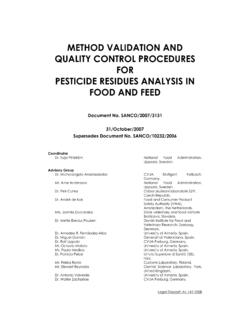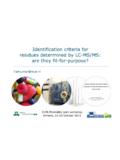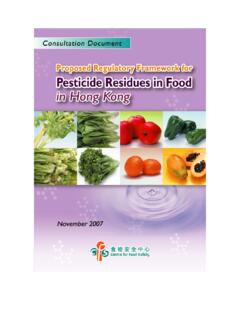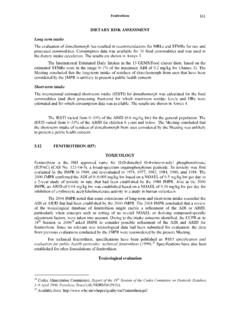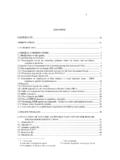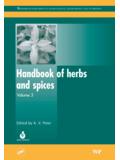Transcription of Background Paper on Occurrence of Melamine in …
1 Background Paper on Occurrence of Melamine in Foods and Feed Prepared for the WHO Expert Meeting on Toxicological and Health Aspects of Melamine and Cyanuric Acid In collaboration with FAO Supported by Health Canada Health Canada, Ottawa, Canada 1 4 December 2008 Prepared by Carla Hilts and Luc Pelletier Bureau of Chemical Safety, food Directorate, Health Products and food Branch, Health Canada, Ottawa, Ontario, Canada World Health Organization Geneva, 2009 iiiCONTENTS 1. DEFINITIONS OF BASELINE, ADULTERATION AND 1 2. POSSIBLE SOURCES OF BASELINE Melamine AND CYANURIC ACID IN food .. 1 Melamine -CONTAINING PLASTIC MATERIALS FOR 1 Melamine Occurrence FROM HERBICIDE/PESTICIDE 3 Melamine IN 5 OTHER SOURCES OF 5 SOURCES OF CYANURIC ACID, AMMELINE AND 6 3.
2 Melamine CONTAMINATION (ADULTERATION).. 6 PET food INCIDENT: 2007 .. 7 THE ADDITION OF Melamine AND RELATED ANALOGUES TO 7 Feed incident: 2007 .. 7 Other occurrences of Melamine in feed .. 10 Melamine -CONTAMINATED MILK INCIDENT IN CHINA: 2008 .. 11 NATIONAL MONITORING AND SURVEILLANCE 12 13 New Zealand .. 14 Republic of Korea .. 14 Taiwan, 15 Canada .. 15 United States of America .. 16 European 16 International food Safety Authorities Network (INFOSAN).. 17 4. RECOMMENDATIONS AND FUTURE WORK .. 18 RECOMMENDATIONS FOR DATA COLLECTION AND 18 RECOMMENDATIONS FOR FUTURE 18 5. 18 APPENDIX 1. SUMMARY OF Occurrence DATA ON Melamine AND RELATED ANALOGUES BY COUNTRY AND food CATEGORY FOR COMPLETE DATA SETS IN WHICH BOTH POSITIVE AND NEGATIVE DETERMINATIONS WERE 25 APPENDIX 2.
3 SUMMARY OF POSITIVE OCCURRENCES OF Melamine REPORTED TO INFOSAN AND THROUGH THE EUROPEAN RAPID ALERT SYSTEM FOR food AND 36 APPENDIX 3. SUMMARY OF Occurrence DATA ON Melamine FOR DAIRY PRODUCTS AND OTHER FOODS CONTAINING MILK INGREDIENTS REPORTED TO THE CONFEDERATION OF food AND DRINK INDUSTRIES OF THE EU (CIAA).. 40 1 1. DEFINITIONS OF BASELINE, ADULTERATION AND MISUSE For this report, the sources of Melamine have been divided into baseline levels, which refer to levels in food that do not result from adulteration or misuse, and adulteration levels, including misuse, which refer to the intentional addition of Melamine to food or unapproved use of Melamine or substances that can degrade to form Melamine .
4 Baseline is defined as levels of Melamine and related analogues in food from accepted uses that do not result from adulteration or misuse. This includes expected levels from the environment, food processing, packaging materials, residues from the legitimate use of triazine pesticides or veterinary drugs, and legitimate use of Melamine in fertilizers or cyanuric acid in feed additives. Adulteration is the intentional addition of Melamine and/or analogues directly to food , food ingredients, animal feed, feed ingredients or pelletizing agents. It may also be present indirectly in foods of animal origin as a result of carryover from the intentional addition to animal feed.
5 Misuse is defined as the inappropriate use of cyromazine or biuret (a ruminant feed additive) in animal feed or use of animal feed containing these additives in species for which it is not intended. 2. POSSIBLE SOURCES OF BASELINE Melamine AND CYANURIC ACID IN food Melamine is a synthetically produced chemical used for a wide variety of applications, including plastics, adhesives, laminates, paints, permanent-press fabrics, flame retardants, textile finishes, tarnish inhibitors, Paper coatings and fertilizer mixtures. In 2007, worldwide production of Melamine was estimated to be around million tonnes (Bizzari & Yokose, 2008). Table 1 provides an estimate of the proportional uses of Melamine around the world.
6 These uses can result in the presence of Melamine in the environment. Melamine can also be present in the environment as a result of the degradation of precursor compounds, such as the dealkylation of the herbicide/pesticide cyromazine. Melamine may be found at trace levels in the food -chain as a result of its presence in the environment. Melamine may also enter the food -chain indirectly through animal feeds that have been treated with products containing Melamine , such as fertilizers or pesticides/herbicides. Owing to the widespread use of Melamine in applications involving contact with food , trace amounts of Melamine may be found in food . The following sections will elaborate on the sources of Melamine and cyanuric acid (a product of Melamine degradation) in relation to their possible presence in food .
7 It is important to note that legitimate uses of these possible sources and/or compounds ( Melamine and analogues) may vary from one country to another. Melamine -containing plastic materials for tableware Melamine is a common monomer in the manufacturing of plastic materials ( Melamine formaldehyde plastics) used to make tableware products such as cups, bowls, plates or utensils. The Melamine formaldehyde polymer is ideal for food contact applications because of its hardness, heat resistance and general stability. These superior characteristics enable the repeated use of Melamine -based tableware; however, repeated use can increase the possibility of Melamine migration into food .
8 Toxicological and Health Aspects of Melamine and Cyanuric Acid 2 Table 1. Estimated proportion of Melamine application by region (FESYP, 1998) Estimated proportion of Melamine application (%) Application Europe, Africa, Middle EastNorth/South America Asia-Pacific WorldLaminates 5345 14 38 Glues, adhesives 245 50 30 Moulding compounds (plastic tableware) 67 18 10 Coatings 722 11 11 Textiles resins, superplasticizers for concrete, flame retardants for polyurethane foams 1021 7 11 Because of the complexity of food matrices and the instability of some chemical migrants, migration data are generally obtained from experiments conducted under controlled conditions rather than using real food systems (De Fatima Pocas & Hogg, 2007).
9 As such, time and temperature contact between the material and the food are controlled. In addition, food simulants such as ethanol or acetic acid are used rather than the food itself to better simulate extreme conditions and increase possible migration. Bradley et al. (2005) tested Melamine migration from 50 samples of Melamine -based tableware from retail outlets in England. Melamine migration was determined in three consecutive exposures of 2 h contact time at 70 C with a solution of 3% acetic acid. Migration was positive (above the limit of quantification [LOQ], which varied with the articles) in 43 of the 50 samples. The level of Melamine in positive samples ranged from to mg/dm2 for articles for which compliance with European Union (EU) limits is demonstrated on an area basis and from to mg/kg for the other two samples.
10 None of the results exceeded the EU specific migration limit (limit on transfer of constituents from plastic materials to foods) for Melamine of 30 mg/kg (equivalent to 5 mg/dm2). Similar results under the same test conditions were found by Lund & Petersen (2006), who subjected 19 samples to 2 h of contact time at 70 C with a 3% acetic acid solution. Only three samples showed Melamine migration (two samples on the first exposure, the other on the third exposure) above the LOQ, and positive results ranged from to mg/dm2. Seven additional exposure periods were utilized on the three positives, and most results were below the LOQ for Melamine . Lund & Petersen (2006) also exposed six specimens of one sample to 10 consecutive exposures with a 3% acetic acid solution at 95 C for 30 min.










